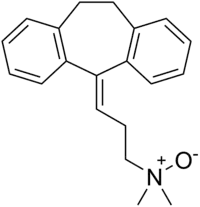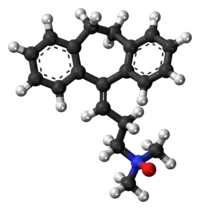Amitriptylinoxide
 | |
 | |
| Clinical data | |
|---|---|
| Trade names | Amioxid, Ambivalon, Equilibrin |
| Routes of administration | Oral |
| ATC code |
|
| Legal status | |
| Legal status |
|
| Identifiers | |
IUPAC name
| |
| CAS Number | |
| PubChem CID | |
| ChemSpider |
|
| UNII | |
| KEGG |
|
| ChEMBL | |
| CompTox Dashboard (EPA) | |
| ECHA InfoCard | 100.119.550 |
| Chemical and physical data | |
| Formula | C20H23NO |
| Molar mass | 293.410 g·mol−1 |
| 3D model (JSmol) | |
SMILES
| |
InChI
| |
| (verify) | |
Amitriptylinoxide (brand names Amioxid, Ambivalon, Equilibrin), or amitriptyline N-oxide, is a tricyclic antidepressant (TCA) which was introduced in Europe in the 1970s for the treatment of depression.[1]
Amitriptylinoxide is both an analogue and metabolite of amitriptyline, and has similar effects as well as equivalent efficacy as an antidepressant.[2][3][4][5] However, it has a faster onset of action and fewer adverse effects, including reduced drowsiness, sedation, anticholinergic symptoms like dry mouth, sweating, and dizziness, orthostatic hypotension, and cardiotoxicity.[2][3][4][5][6][7]
In receptor binding assays, amitripylinoxide was found to have generally equivalent pharmacology to amitriptyline, acting as a serotonin and norepinephrine reuptake inhibitor, serotonin receptor antagonist, and H1 receptor antagonist, among other properties, but with approximately 60-fold lower affinity for the α1-adrenergic receptor, and the weakest affinity of any of the TCAs analyzed for the muscarinic acetylcholine receptors.[8][9][10]
Amitriptylinoxide has been said to be a prodrug of amitriptyline.[11]
See also
References
- ↑ Swiss Pharmaceutical Society (2000). Index Nominum 2000: International Drug Directory (Book with CD-ROM). Boca Raton: Medpharm Scientific Publishers. p. 49. ISBN 3-88763-075-0.
- 1 2 Rapp W (September 1978). "Comparative trial of amitriptyline-N-oxide and amitriptyline in the treatment of out-patients with depressive syndromes". Acta Psychiatrica Scandinavica. 58 (3): 245–55. doi:10.1111/j.1600-0447.1978.tb06936.x. PMID 360779. S2CID 12666498.
- 1 2 Tegeler J, Klieser E, Lehmann E, Heinrich K (January 1990). "Double-blind study of the therapeutic efficacy and tolerability of amitriptylinoxide in comparison with amitriptyline". Pharmacopsychiatry. 23 (1): 45–9. doi:10.1055/s-2007-1014481. PMID 2179974.
- 1 2 Godt HH, Fredslund-Andersen K, Edlund AH (1971). "[Amitriptyline N-oxide. A new antidepressant. A clinical double-blind trial in comparison with amitriptyline]". Nordisk Psykiatrisk Tidsskrift. Nordic Journal of Psychiatry (in Danish). 25 (3): 237–46. doi:10.3109/08039487109094663. PMID 4945956.
- 1 2 Aronson, Jeffrey Kenneth (2008). Meyler's Side Effects of Psychiatric Drugs (Meylers Side Effects). Amsterdam: Elsevier Science. p. 30. ISBN 978-0-444-53266-4.
- ↑ Wenzl H, Graf E, Sieck A (1978). "Central nervous effects of a new tricyclic antidepressant (amitriptylinoxide)". Arzneimittel-Forschung. 28 (10b): 1874–9. PMID 261811.
- ↑ Dencker SJ (1971). "[Clinical trial with imipramine-N-oxide and amitriptyline-N-oxide]". Nordisk Psykiatrisk Tidsskrift. Nordic Journal of Psychiatry (in Swedish). 25 (5): 463–70. doi:10.3109/08039487109094696. PMID 4947298.
- ↑ Borbe HO, Zierenberg O (September 1985). "Amitriptylinoxide: receptor-binding profile compared with other antidepressant drugs". Pharmacopsychiatry. 18 (5): 314–9. doi:10.1055/s-2007-1017388. PMID 2996040.
- ↑ Maj J, Vetulani J, Michaluk J, Rogóz Z, Skuza G (November 1982). "Central action of amitriptyline N-oxide". Pharmacopsychiatria. 15 (6): 187–91. doi:10.1055/s-2007-1019536. PMID 6185962.
- ↑ Hyttel J, Christensen AV, Fjalland B (July 1980). "Neuropharmacological properties of amitriptyline, nortriptyline and their metabolites". Acta Pharmacologica et Toxicologica. 47 (1): 53–7. doi:10.1111/j.1600-0773.1980.tb02025.x. PMID 7395525.
- ↑ Pavel Anzenbacher; Ulrich M. Zanger (23 February 2012). Metabolism of Drugs and Other Xenobiotics. John Wiley & Sons. pp. 302–. ISBN 978-3-527-64632-6.
| |||||||||||||||||||||||||||||||||||||||||||||||||||||||||||||||||||||||||||||||||||||||||||||||||||||||||||||||||||||||||||||||||||||||||||||||||||||||||||||||||||||||||||||||||||||||||||||||||||||||||||||||||||||||||||
| Classes |
|
|---|---|
| Antidepressants (TCAs and TeCAs) |
|
| Antihistamines |
|
| Antipsychotics |
|
| Anticonvulsants | |
| Others |
|